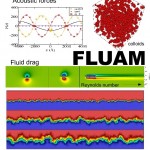Thesis Defense – Minimal Models for Finite Particles in Fluctuating Hydrodynamics
 Tuesday, 25th February 2014, 12.00
Tuesday, 25th February 2014, 12.00
Place: Sala de seminarios módulo 5 (5ª planta), Facultad de Ciencias.
Program: Defense by Mr. Florencio Balboa Usabiaga, Department of Theoretical Condensed Matter Physics, Universidad Autónoma de Madrid.
Title: Minimal models for finite particles in fluctuating hydrodynamics
Thesis Director: Rafael Delgado Buscalioni
This thesis has been devoted to the development of numerical methods to resolve the dynamics of fluids and immersed solute particles in scales above 100 nanometers, where thermal fluctuations are important. Solving fluctuanting hydrodynamics requires ensuring thermodynamic consistency (the equilibrium distribution is canonical) and to that end we have used the Augmented Langevin Formalism which, consistently with the Fokker-Planck equation, furnishes the extra forces (stochastic and thermal drifts) required for the fluctuation-dissipation balance to hold. The fluid equations (Navier-Stokes-Landau-Lipshitz) have been discretized by the finite volume method using a staggered grid. In general the algorithms developed are of second order accuracy and very efficient, due to the use of semi-implicit schemes which permit usage of Fast-Fourier-Transform. The formalism has been generalized to the different hydrodynamic regimes naturally arising from the fluid separation of time scales: compressible or incompressible flows, at large or low Reynolds numbers and either inertial or viscous dominated. On the other hand, we have develped minimal resolution models to describe the dynamics of immersed particles using the Immersed Boundary method and the no-slip constraint to derive the hydrodynamic force to the particles. This idea permits to describe the particle physical properties (mass, volume, compressibility, inertia) and can be extended to deal with the Brownian limit up to the turbulent regime. To name two applications, inertia is essential to describe the acoustic forces arising from ultrasound devices, and conservative particle-particle interactions can be added to analyze the structure-dynamic relation in flowing colloidal dispersions. The thesis brings a novel, fast and versatile tool for particle hydrodynamics, named as FLUAM. It has been written in CUDA for computations in fast graphic cards (GPU’s). As initial applications, among others, we have studied giant concentration fluctuations under microgravity, acoustic tweezers, the limit of the classical Stokes-Einstein relation and the dynamics polymers under shear.



















